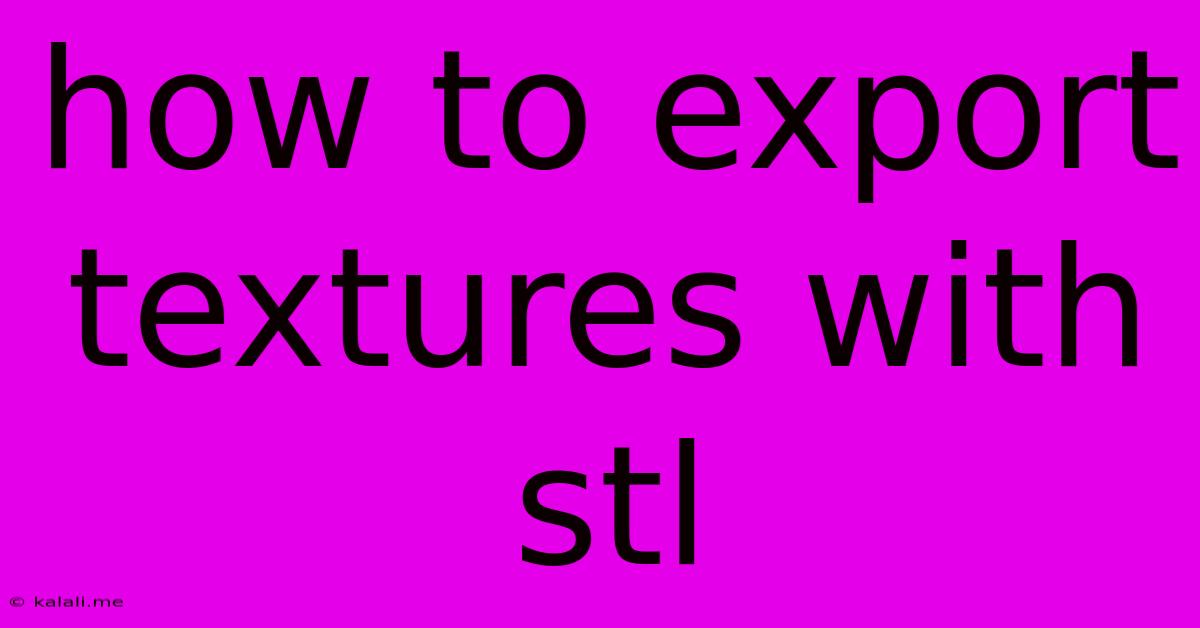How To Export Textures With Stl
Kalali
Jun 09, 2025 · 4 min read

Table of Contents
How to Export Textures with STL Files: A Complete Guide
Meta Description: Learn how to effectively export textures with your STL files for 3D printing and digital design. This guide covers different software options and best practices for preserving texture details.
Exporting textures alongside your STL files is crucial for achieving a realistic and visually appealing final product, whether you're 3D printing or working with digital models. While the STL format primarily stores the 3D model's geometry, it doesn't inherently contain texture information. This means you need to employ specific methods and often utilize external files to maintain your texture mapping. This guide will walk you through the process, covering various software options and best practices.
Understanding the Limitations of STL
STL (Stereolithography) files are primarily designed to represent the surface geometry of a 3D model. They define the model's surface as a mesh of interconnected triangles, specifying the coordinates of each vertex. Crucially, they don't include information about color, materials, or textures. This is why separate texture files are necessary.
Methods for Exporting Textures with STL
The process of exporting textures depends heavily on the 3D modeling software you are using. Most professional software packages offer robust tools for managing and exporting textures alongside your geometry. Here's a breakdown of common approaches:
1. Using External Texture Files:
This is the most common method. You export your STL file as usual, then separately export your texture maps (typically in formats like JPG, PNG, or TIFF). The texture file names and locations are then linked to the model through a process that varies depending on your software and intended application.
- File Naming Conventions: Use clear and consistent naming conventions (e.g.,
model_name.stl,model_name_diffuse.jpg,model_name_normal.png). This will help maintain organization and prevent confusion. - Texture Paths: When importing the STL and textures into your slicer or other software, you'll need to specify the path to your texture files. Ensure the paths are correct to avoid errors.
2. Software-Specific Workflows:
Many 3D modeling programs (Blender, Maya, 3ds Max, ZBrush, etc.) offer integrated workflows for exporting textures and materials with the geometry. These usually involve exporting a scene file (e.g., .blend for Blender, .mb for Maya) that bundles the STL data with embedded or linked texture references. However, the recipient will still need the same software or a compatible plugin to access and utilize the textures correctly.
3. Utilizing Third-Party Plugins:
Some plugins provide enhanced texture export capabilities within your 3D modeling software. These can automate the process, handle various texture formats, and simplify the workflow. Research plugins compatible with your specific software for potential improvements.
Best Practices for Texture Export
- Image Resolution: Use appropriate image resolutions for your textures. Higher resolutions provide greater detail but increase file sizes. Find a balance based on your model's complexity and intended use.
- File Formats: PNG is generally preferred for textures due to its support for alpha channels (transparency) and lossless compression. JPG can be suitable for color textures, but it's lossy, meaning some detail might be lost.
- Texture Mapping: Before exporting, ensure your UV mapping is correctly done. Poor UV mapping can lead to distorted or stretched textures on your 3D model.
- File Organization: Keep your STL files and associated textures organized in a clear folder structure to avoid confusion and streamline your workflow.
Software Examples (General Principles)
While detailed instructions depend on your specific software, the core principles remain consistent:
- Blender: Export your STL, then use the correct export settings (likely within the "UV/Image editor") to save your textures.
- Maya: Similar to Blender, Maya will allow you to specify your texture file paths during export or via its scene file format.
- 3ds Max: 3ds Max handles texture management within its material editor, allowing you to define and export materials along with your geometry.
- ZBrush: ZBrush focuses on sculpting, so exporting textures usually involves painting directly onto the model and then exporting the texture maps separately after the sculpting is complete.
Remember to always consult your software's documentation for the most accurate and up-to-date instructions on exporting textures with STL files. The process may involve different menu options and settings depending on the version of your software. By following these guidelines, you can ensure your 3D models look their best, regardless of whether they're intended for 3D printing or digital display.
Latest Posts
Latest Posts
-
What Kind Of Oil Does Subway Use
Jun 09, 2025
-
Can X Be Negative In Standard Form
Jun 09, 2025
-
What Do These Words Have In Common
Jun 09, 2025
-
How To Stick Whiteboard On Wall
Jun 09, 2025
-
Removing Wires From Push In Connectors
Jun 09, 2025
Related Post
Thank you for visiting our website which covers about How To Export Textures With Stl . We hope the information provided has been useful to you. Feel free to contact us if you have any questions or need further assistance. See you next time and don't miss to bookmark.